Gujarat Tribal Tour
With the knock of modernization in India, finding the old culture, traditions s well as the ancient people is not an easy job. However, there are still some states in India where one can refresh himself and have a glimpse of the old Indian people and their simple lifestyle. One such Indian state is Gujarat. Apart from unspoiled beaches, medieval edifices and rich Indian culture and tradition, the state is well acknowledged worldwide for its tribal life.
Explore the sizable population of tribals in Gujarat with our 12 nights and 13 days Gujarat Tribal Tour. Our tour will allow you to meet different tribes of the state and closely witness their lifestyle, culture and traditions. This travel package will give you a chance to slip into the lifestyle of Gujarat.
Day 01: Arrive Ahmedabad
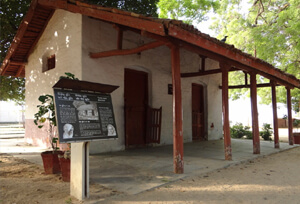 Upon arrival at Ahmedabad airport, meet with our representative and transfer to the hotel. After fresh-n-up, we will visit the Gandhi Ashram, located on a quiet peaceful stretch of the Sabarmati River, Mahatma Gandhi set up a simple retreat in 1915. This was his Satyagrah Ashram and for many years it was the nerve centre of India’s freedom movement. It was from here in 1930, that Mahatma began his famous Dandi March to the sea for protest against the Salt Tax imposed by the British. Hridaya Kunj, the simple cottage where he lived, is now a national monument and preserved as it was during the Mahatma’s life-time.
Upon arrival at Ahmedabad airport, meet with our representative and transfer to the hotel. After fresh-n-up, we will visit the Gandhi Ashram, located on a quiet peaceful stretch of the Sabarmati River, Mahatma Gandhi set up a simple retreat in 1915. This was his Satyagrah Ashram and for many years it was the nerve centre of India’s freedom movement. It was from here in 1930, that Mahatma began his famous Dandi March to the sea for protest against the Salt Tax imposed by the British. Hridaya Kunj, the simple cottage where he lived, is now a national monument and preserved as it was during the Mahatma’s life-time.
Later, return to the hotel for an overnight stay.
Day 02: Ahmedabad - Poshina
After breakfast we will leave for Poshina. On arrival, check into the hotel. After fresh-n-up, we will explore the villages of Poshina. Here, we will meet with the Garasia tribal. The village of Poshina is home to a number of artisans the tribal arrow crafters, potters, blacksmiths and the bazaar is famous for silver tribal jewellery, ornate sheathed daggers and terra cotta horses. Around Poshina are hamlets of the Bhil and Garasia tribal communities, known for their colourful attires and artistic ornaments. An overnight stay at the hotel.
Day 03: Full day in Poshina
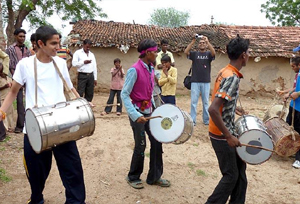 Today, we will go for a full day excursion to Danta village. Here, we will meet with the Dungri Garasia tribes. The Garasias are bisected in two neighbouring states, Gujarat and Rajasthan. Dungri Garasia is generic term, covering half a dozen endogamous hierarchical sub-tribes calling themselves Garasia or Dungri Garasia. Garasia is very close to Bhil. Due to paucity of good agriculture land, there are a few chances of sustainable agriculture and animal husbandry.
Today, we will go for a full day excursion to Danta village. Here, we will meet with the Dungri Garasia tribes. The Garasias are bisected in two neighbouring states, Gujarat and Rajasthan. Dungri Garasia is generic term, covering half a dozen endogamous hierarchical sub-tribes calling themselves Garasia or Dungri Garasia. Garasia is very close to Bhil. Due to paucity of good agriculture land, there are a few chances of sustainable agriculture and animal husbandry.
In the evening return to Poshina for an overnight stay.
Day 04: Poshina - Patan - Modhera - Dasada
After breakfast, we will leave for Dasada. En-route we will visit Patan and Modhera. The village is famous for its Patola weaving by Salvi community. Here, we will see how they work on weaving and let of Patna fabric come out. Watch the Mushroom fabrics woven as a combination of silk & cotton with the latter forming the backing, dying and design.
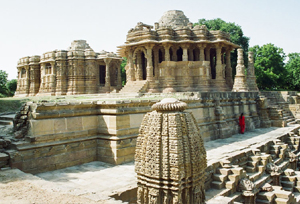 Further, we will visit the Rani Ki Vav, Patan Step Well, built by the queen Udaymati, the wife of Bhimdev. These are some of the best example of such architecture for water wells that is peculiar to Gujarat. There are wonderful carved images in the niches of the walls of this multi storied step well. It was one of the largest and the most sumptuous structures of its type. Among its ruins, one pillar still stands which is the proof not only of the elegance of its design, but also excellent example of this period.
Further, we will visit the Rani Ki Vav, Patan Step Well, built by the queen Udaymati, the wife of Bhimdev. These are some of the best example of such architecture for water wells that is peculiar to Gujarat. There are wonderful carved images in the niches of the walls of this multi storied step well. It was one of the largest and the most sumptuous structures of its type. Among its ruins, one pillar still stands which is the proof not only of the elegance of its design, but also excellent example of this period.
Later, drive to visit Modhera Sun temple-dedicated to god Sun. The Sun temple of Modhera was built in 1026 AD during the reign of the Solanki king Bhima, Modhera Sun temple marks the peak of revolution in Indo-Aryan Hindu temple form Typology. It is positioned in such a manner that the rising sun rays illuminate the deity in the innermost sanctum sanctorum through the main entrance at the time of equinox only.
After visiting the Sun temple, we will leave for Dasda. On reaching, transfer to the hotel for a night stay.
Day 05: Dasada
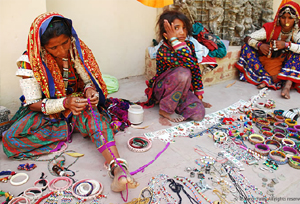 Today, after breakfast we will enjoy our jeep safari to the Little Rann of Kutch to see the famous wild Ass. Apart from wild Ass, we will be able to sight Blackbuck (Indian antelope), Nilgai or Blue Bull, the graceful chinkara, Indian Wolf, Desert Fox, Indian Fox, Jackals, Desert and Jungle Cats, hyenas and in migratory birds like Flamingos, Pelicans, Ducks, Cranes and Storks etc.
Today, after breakfast we will enjoy our jeep safari to the Little Rann of Kutch to see the famous wild Ass. Apart from wild Ass, we will be able to sight Blackbuck (Indian antelope), Nilgai or Blue Bull, the graceful chinkara, Indian Wolf, Desert Fox, Indian Fox, Jackals, Desert and Jungle Cats, hyenas and in migratory birds like Flamingos, Pelicans, Ducks, Cranes and Storks etc.
Later, return to the hotel for lunch. After lunch, it’s time to explore the Rabari and Bhairwad tribal villages around Dasada. We will visit the rural Vadiara and Kharapat Rabaris of Dasada, known for their embroideries, the silk-weavers colony at Dasada and Ambala village of the Bharwad shepherds and goatherds. The weaving cooperative at Bajana and other artisan’s workshops can also be included in the tours. Other societies near Dasada are Padhars (primarily fishing people), the Siddis and the semi-nomadic Mirs, Jaths (Muslim herders), Bajanias.
Later, return back to the hotel for an overnight stay.
Day 06: Dasada - Bhuj
After breakfast, we will leave for Bhuj. On arrival, check into the hotel. After fresh-n- up we will visit the Collector's office to obtain the permit for next 02 days to explore its tribal. After that one can go for a visit to the nearby tribal market. In the evening, return back to the hotel for an overnight stay.
Day 07: Bhuj - Bani Village - Bhuj
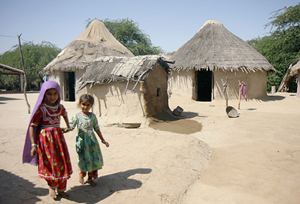 Today after breakfast, we will go for a full day excursion to Banni group of villages. Here, we will be visiting the villages of Hodka, Ludiya and Dhordo to meets its native, which are Jat, Harijan, Meghwal and Mutva, etc.
Today after breakfast, we will go for a full day excursion to Banni group of villages. Here, we will be visiting the villages of Hodka, Ludiya and Dhordo to meets its native, which are Jat, Harijan, Meghwal and Mutva, etc.
Banni: In Banni area of Kutch the Meghwal-Harijans who migrated from Rajasthan use Kambira, Kharek, Kudi Stitches in their embroidery. Also outline and satin stitch embroidery of the area and very minute mirror designs similar to the famous Mutwa embroidery of the area. They make wall hangings, waistcoats and pouches in Kharek Stitch and do 'Moti Bharat' or beadwork on handheld fans, bracelets, toys and belts.
Hodka: The Hodka derives from the Gujarati word ‘Hodi’ which means ‘boat’. Since, the villages here are called jheels, where potable water is available. Hodka is famous for its beautiful embroidery and mud work as much as leather craft. Both men and women are actively involved in developing the art and craft tradition of the region.
Ludiya village: Harijans and Muslims are main communities in this village. The main occupations of the local here are monsoon farming, cattle rearing, intricate wood carving, intricate embroidery work, mud-work and wall painting for decorating homes. Harijan men are involved with wood carving, the women take up embroidery and wall-decoration.
Dhordo: The place is best to see beautiful traditional mud houses (Bhungas) with mirror work and its fine Mutwa embroidery with tiny mirrors.
In the evening return to the hotel for an overnight stay.
Day 08: Bhuj
Today, we will visit the village of Bhujodi. Here, we will see their artisans in weaving thick shawls and blankets. The ancient tradition of weaving shawls and blankets from coarse sheep hair came into existence generations ago essentially as a form of barter between the "Rabari" community or the nomadic grazing community and the vankars (weavers).
After Bhujodi, we will drive to Tundav and to explore the village of Rabaris, around 200 Rabari families live here in around houses. The women are dressed in black woollen clothes. Further, visit to Nirona village to have a glimpse of the highly productive craft producing area they made lacquered wooden goods. Also, visit several artisans and admire their unique crafts like Roghan painting clothes, copper bell making, lacquer work on wood and woollen shawl weaving.
Later, return to the hotel for a night stay.
Day 09: Bhuj - Dholavira - Wankaner
After breakfast, we will leave for Wankaner. En-route we will visit the deserted village of Dholavira to explore its archaeological site. Further, continue drive to Wankaner. On reaching here, transfer to the hotel for an overnight stay.
Day 10: Wankaner - Jambughoda
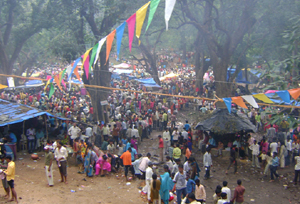 Today, we will have an excursion to the Lothal Ruins, which is famous for Harappan civilization. Further, we will visit Champaner.
Today, we will have an excursion to the Lothal Ruins, which is famous for Harappan civilization. Further, we will visit Champaner.
Champaner: It is an ancient fortified city. There are two stories about the origin of the name of this town. Some believe that is named after Champaraj who was the founder of the city, while others believe that the town was named after the Champa Tree which is found here.
Visit Champaner Fort. It is an ancient fort located at the foothills of Pavagadh. Mohammed Begada (The famous Muslim King of Gujarat) captured the fort in 15th Century after a long siege against the Khichi Chauhan Rajputs. Later, continue drive to Jambughoda. On arrival, check into the hotel for an overnight stay.
Day 11: Jambughoda (Chhota Udaipur)
After breakfast, full day excursion Chhota Udepur to visit the villages Rathwa and Nayak tribes. Also, visit the weekly market for Udepur (weekly market - held every day at different villages). On the way back to the hotel, we will visit the local houses in Pithora painting. An overnight stay at the hotel.
Day 12: Jambughoda - Ahmedabad
After breakfast, leave for Ahmedabad. On arrival, check into the hotel. Evening is free for leisure. An overnight stay at the hotel.
Day 13: Ahmedabad - Departure
After breakfast, leave for Ahmedabad. On arrival, check into the hotel. Evening is free for leisure. An overnight stay at the hotel.
Tour and services Ends.









 Upon arrival at Ahmedabad airport, meet with our representative and transfer to the hotel. After fresh-n-up, we will visit the Gandhi Ashram, located on a quiet peaceful stretch of the Sabarmati River, Mahatma Gandhi set up a simple retreat in 1915. This was his Satyagrah Ashram and for many years it was the nerve centre of India’s freedom movement. It was from here in 1930, that Mahatma began his famous Dandi March to the sea for protest against the Salt Tax imposed by the British. Hridaya Kunj, the simple cottage where he lived, is now a national monument and preserved as it was during the Mahatma’s life-time.
Upon arrival at Ahmedabad airport, meet with our representative and transfer to the hotel. After fresh-n-up, we will visit the Gandhi Ashram, located on a quiet peaceful stretch of the Sabarmati River, Mahatma Gandhi set up a simple retreat in 1915. This was his Satyagrah Ashram and for many years it was the nerve centre of India’s freedom movement. It was from here in 1930, that Mahatma began his famous Dandi March to the sea for protest against the Salt Tax imposed by the British. Hridaya Kunj, the simple cottage where he lived, is now a national monument and preserved as it was during the Mahatma’s life-time. Today, we will go for a full day excursion to Danta village. Here, we will meet with the Dungri Garasia tribes. The Garasias are bisected in two neighbouring states, Gujarat and Rajasthan. Dungri Garasia is generic term, covering half a dozen endogamous hierarchical sub-tribes calling themselves Garasia or Dungri Garasia. Garasia is very close to Bhil. Due to paucity of good agriculture land, there are a few chances of sustainable agriculture and animal husbandry.
Today, we will go for a full day excursion to Danta village. Here, we will meet with the Dungri Garasia tribes. The Garasias are bisected in two neighbouring states, Gujarat and Rajasthan. Dungri Garasia is generic term, covering half a dozen endogamous hierarchical sub-tribes calling themselves Garasia or Dungri Garasia. Garasia is very close to Bhil. Due to paucity of good agriculture land, there are a few chances of sustainable agriculture and animal husbandry.  Further, we will visit the Rani Ki Vav, Patan Step Well, built by the queen Udaymati, the wife of Bhimdev. These are some of the best example of such architecture for water wells that is peculiar to Gujarat. There are wonderful carved images in the niches of the walls of this multi storied step well. It was one of the largest and the most sumptuous structures of its type. Among its ruins, one pillar still stands which is the proof not only of the elegance of its design, but also excellent example of this period.
Further, we will visit the Rani Ki Vav, Patan Step Well, built by the queen Udaymati, the wife of Bhimdev. These are some of the best example of such architecture for water wells that is peculiar to Gujarat. There are wonderful carved images in the niches of the walls of this multi storied step well. It was one of the largest and the most sumptuous structures of its type. Among its ruins, one pillar still stands which is the proof not only of the elegance of its design, but also excellent example of this period.  Today, after breakfast we will enjoy our jeep safari to the Little Rann of Kutch to see the famous wild Ass. Apart from wild Ass, we will be able to sight Blackbuck (Indian antelope), Nilgai or Blue Bull, the graceful chinkara, Indian Wolf, Desert Fox, Indian Fox, Jackals, Desert and Jungle Cats, hyenas and in migratory birds like Flamingos, Pelicans, Ducks, Cranes and Storks etc.
Today, after breakfast we will enjoy our jeep safari to the Little Rann of Kutch to see the famous wild Ass. Apart from wild Ass, we will be able to sight Blackbuck (Indian antelope), Nilgai or Blue Bull, the graceful chinkara, Indian Wolf, Desert Fox, Indian Fox, Jackals, Desert and Jungle Cats, hyenas and in migratory birds like Flamingos, Pelicans, Ducks, Cranes and Storks etc. Today after breakfast, we will go for a full day excursion to Banni group of villages. Here, we will be visiting the villages of Hodka, Ludiya and Dhordo to meets its native, which are Jat, Harijan, Meghwal and Mutva, etc.
Today after breakfast, we will go for a full day excursion to Banni group of villages. Here, we will be visiting the villages of Hodka, Ludiya and Dhordo to meets its native, which are Jat, Harijan, Meghwal and Mutva, etc.  Today, we will have an excursion to the Lothal Ruins, which is famous for Harappan civilization. Further, we will visit Champaner.
Today, we will have an excursion to the Lothal Ruins, which is famous for Harappan civilization. Further, we will visit Champaner.
